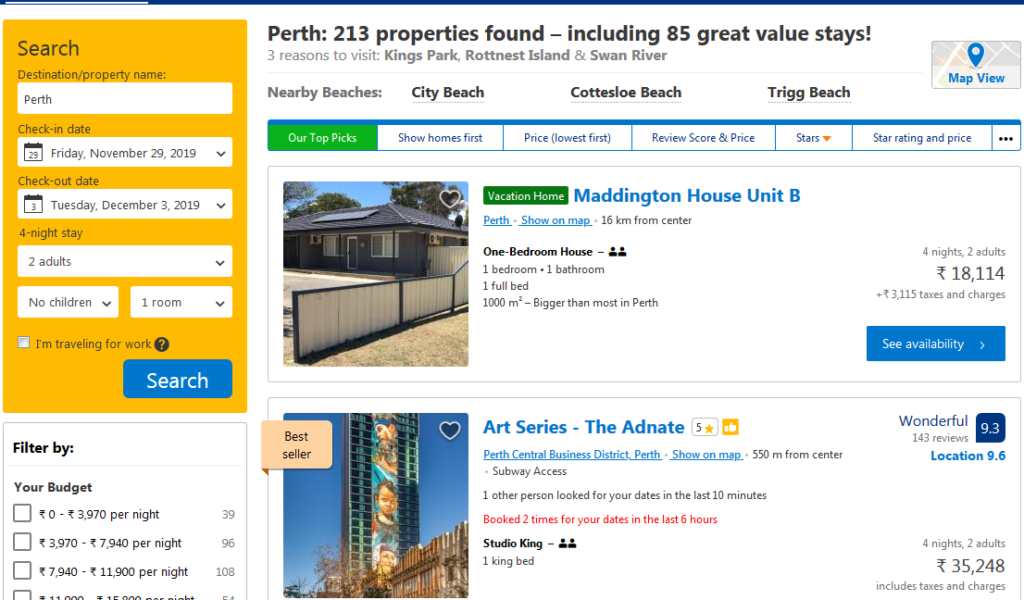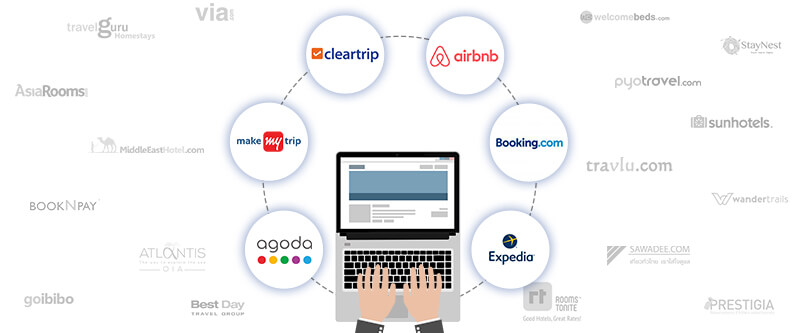The hospitality industry has seen a revolution with the emerging trend of online booking sites. In addition to booking from hotel’s own websites, travelers now compare various properties on travel sites before making a booking.
It is not a hidden fact that OTAs are a source of easy marketing for hoteliers, which let their rooms be sold to a larger audience.
Therefore, to select the right OTAs and more importantly the combination of all of them is critical to get more bookings.
Here’s a complete guide with several factors to consider when you select the right OTAs in your distribution strategy.
What are OTAs in hotel industry?
OTAs or better known as online travel agents are websites which provide a platform to users/travelers to book several travel services viz. airlines, hotels, trains, cars, holiday packages from one portal. In turn of the bookings made, these sites charge a part of the total amount as a commission to the businesses listed on their sites, which is usually in percentage (%).
Hotels on which accommodation providers can get registered, showcase their availability and sell their rooms to the travelers worldwide.
OTAs came into existence in the mid 90’s as a platform for selling excess room inventory during low demand season.
In the present day, OTAs are dominating the whole hospitality industry. They are popular as listing sites where accommodation providers can register themselves to make their property more visible to a larger audience.
Basically, OTAs help you connect your hotel property or chain of hotels to a global audience, driving more bookings and revenue online.
Believing on numbers,
In 2016 year alone, TripAdvisor – the leading travel site and OTA generated almost 1.1 billion visits to its site.
Soft Inn
This number is not going down anytime soon. Suffice to say, OTAs are getting majority of visibility from travelers worldwide.
But a common question I face while dealing with hotels is —
How important are OTAs in selling your hotel rooms?
Believe it or not, today, a major chunk of reservations are made through these online platforms. This has made OTAs an essential component of all lodging operators’ distribution strategies — often accounting for the majority of a property’s revenue.
If we let numbers do the talking,
76% of online bookings happen via OTAs
20% of your direct bookings come from people that have discovered your hotel through an OTA
Soft Inn
As the majority of travel and hospitality providers offer their inventory via OTAs, any traveler or guest has a one-stop-shop for comparative shopping.
Benefits of OTAs for hotels
Since their introduction, OTAs have increasingly gained market share, currently capturing 39% of the US online digital booking market. It is a win win situation for the property managers to select the right OTAs. Here’s how you are benefited:
- Your property gets global visibility: Listing on OTAs having a wide demographic reach gets you the much-needed visibility and exposure which will establish your brand in the market.
- You receive a good number of bookings: OTAs give your hotel a platform to receive bookings 24×7, from any corner of the world.
- You get reviews from guests: On OTAs, you get more reviews for your property that facilitate bookings and is a passive publicity strategy too
On the other hand, travelers get a better view of the kind of properties they want to access at a certain location. This helps them compare hotels and make a well informed decision.
Registering on OTAs distributes your hotel rooms to both domestic and international audiences which is a difficult task otherwise. Showing details in the appropriate language and currency helps you to welcome guests from all over the world.
That’s why you should select the right OTAs having appropriate credibility which give your hotel the proper amount of reach and visibility.
Which factors determine your OTAs selection?
There are a variety of OTAs in the market today and each of them work on a different booking model. It is vital that you don’t just register on any random OTA and pick up the ones that will suit your property the best.
There are certain things that should be avoided and considered while choosing the OTA. These factors will help you make the right decision:
1. Your target audience
What kind of people you cater to plays a very essential role in listing your property on the OTAs. Since several OTAs these days are made to target a specific market segment to assist travelers in booking quickly, you can definitely make the most of this opportunity.
If you are a hostel in Netherlands, register on Gomio.com, or hostelsclub.com to attract domestic guests from neighbouring areas. Similarly, for international guests, Expedia, Booking.com are a popular choice. For backpackers; hostelworld.com, hostels.com and such likes are the right OTAs.
You are the best judge for the type of guests that your hotel wishes to entertain and same should be taken into account while registering on different OTAs.
2. The demographic reach of the OTA
Almost all OTAs are geo specific. They cater to audiences from specific geographical locations or regions. It thus becomes essential to know where the majority of your guests are coming from?
The first step in doing so could be finding out where do tourists come from in your city.
Local OTAs are the best platforms to capture your local guests and guests from surrounding cities or regions.
For example: Camholidays.com attracts people to book hotels in Cambodia on its portal, whereas Travelguru is specific to people from the south Indian states, and so on.
Choosing local OTAs makes sure that you have reached out and are known to the local public. Because of this, there are chances of local promotions as well.
For that reason, you should be aware of the local OTAs of your region before you include them in your distribution strategy. Select the right OTAs like Pegi Pegi (Indonesia), Travlu (Canada), Rurubu (Japan) and more to get an added advantage of attracting guests from particular regions or countries.
3. Your property type
Not all OTAs are suitable for all types of properties. Depending on the category of your property and the amenities that you offer in your hotel, choosing the right OTAs will vary too.
For instance: Expedia is suited to sell 5 star and luxury rooms; whereas Treovi, hostelworld.com are best to sell budget rooms and hostels. Independent hotels for solo travellers sell well on AirBnB, hotels.com; bed and breakfast type properties sell best on bedandbreakfast.com, flipkey.com with a low commission rate.
If you select the right OTA which suits your property type, it will make selling your rooms faster and better.
4. Commission model
One of the biggest concerns while partnering with an OTA is the budget that your property has kept aside for commissions.
Now, each OTA has a different commission model. When registering, make sure you know what each OTA will charge you for booking a room through its website. Start with the ones that charge lower commission.
When determining if an OTA is worth the cost, remember to account for your guests’ lifetime value or the customer lifetime value (CLV) brought in.
5. OTA’s efforts to increase your visibility and bookings
Along with listing hotels on their websites, OTAs often run loyalty or reward programs to promote hotels. You may decide your listings based on how effective the promotions or such programs are.
There can be discounts offered per booking or free nights offered that draws guest’s attention and increases bookings eventually. Offering discount programs merges well with traditional OTA users who look for great deals on OTA platforms. For example, these programs are most popular among hotels in the US:
- Expedia Rewards: up to 2 points per $1 USD
- Hotels.com: Stay 10 nights, get 1 free.
- Orbitz Rewards: Earn $1 Orbuck for every $1 USD spent.
- Rocketmiles, Kaligo, Agoda: No program, but earn airline miles of your choice.
Booking.com’s Preferred Partner program is also an established approach to boost visibility. Properties with an average rating score of 7.0 or higher are categorised as “preferred” and get extra visibility in the search results, next to a ‘thumbs-up’ sign.

This gives the hotel a unique push towards better visibility and bookings.
A larger number of customers can easily see that your property is recommended and is booked by a lot of travellers.
Preferred partners get an average of up to 65% more page views and 35% more bookings.
Such programs are an added advantage when listing your property on OTAs and should be taken into account when selecting the right mix.
6. Rate parity maintenance
Rate parity is another very important factor. It is mandatory to follow the legal agreement between hotel and OTA to maintain the same rate for the same room across all distribution channels.
Understand the concept and share the same with your staff so that they take care of the rate parity, not leaving you in an unavoidable situation with the OTAs.
Know the consequences of not adhering to this law with each OTA. Many OTAs discontinue your listing forever, while some barr for a few months.
OTA registration has to be planned strategically while setting up your property on all the OTAs. It is a good idea to diversify the registration, i.e. be present on multiple OTAs rather than relying on only 1 or 2 of them. Read our blog to know why should you have more OTA connections.
The abundance and popularity of these platforms has made it difficult for hoteliers to choose where to register and where not. But after you consider these factors, there’s very little you need to think of before you select the right OTAs for your property.
How to select the right OTA combination?
The right set of distribution channels will vary for each property. You can hit the right audience and get more bookings with appropriate research after knowing all the aspects of each channel and ROI besides considering the above mentioned factors.
Here’s a quick insight on what else should you know about the OTAs you consider registering on.
1. Pros and cons of each OTA
Before selecting the right OTAs, know the pros and cons that you might have to face. While OTAs give you a lot of freedom to list and sell your rooms as per your preferences; there might be hidden charges or commissions that you might not know of.
Or there might be policies to restrict your bookings in certain way. Each platform has a different way of offering rooms. Some display prices per adult, some display per room. Hostels display prices per bed and so on.
So, I recommend you to step in the shoes of a traveler. Spend some time on the OTA to know the ease of booking and take into account all the perspectives that a guest might have. Gather as much knowledge from the online support team before listing your property with an OTA.
2. Resources to maintain the OTA listings
Registering only is not enough on these online booking sites. You will need a resource to maintain the same as well. (You’d not want overbookings, or guests not booking with you because of unattractive pictures).
Uploading rates, inventories, offering discount, and keeping the listing up-to-date is one of the many things you need to constantly work upon.
Though, this can be quite a challenging task if you are not using a channel manager. Because, as humans, you may tend to make a mistake or your hired staff may not do this efficiently and accurately every time.
On those lines, select the right OTAs for your hotel and consider the cost of a channel manager against them.
Furthermore, check out tips to improve your ranking on OTAs like TripAdvisor, Booking.com and more.
3. Commissions vs bookings
No doubt, online travel sites are an economical way to list and sell your rooms. On the contrary, there are high commission involved ranging from 2-10% or more on each booking.
Now, this might not always be in proportion with the profit earned from each room.
That’s the reason, it is advised to know the commission before registering on OTAs. A clear picture of the ROI from that particular OTA is necessary before selling your room on the site.
Besides these, you can also consider various technical details of the OTA viz. time taken to push the inventory and rate updates, credibility in the industry, connectivity with leading channel managers and several others.
In conclusion
OTAs give a great exposure to your property, along with a prominence on Google and other search engines. They indeed are a very economical way to advertise your property.
I recommend that you:
- maintain a good profile of your property on all OTAs,
- Upload clear pictures of your complete property,
- respond to positive and negative reviews,
- mention all amenities and attractions of your property and
- keep the rates up to date always.
OTAs are recognized worldwide. They are popular and trusted by all. Besides, they produce bookings without the manual process of dealing directly with emails and phone calls. This helps the hoteliers to get on with their business of running a hotel.
Once people have booked through OTA, channel them to book through your own website, as there is no commission involved and you can keep your own rates too.
Rooms sell well with offers and discounts. Keep adding offers like last-minute deals, coupon codes, festival discounts and attract customers to book your property quickly.
Allocate your inventory based on trends and insights. Manage your inventory wisely through a channel manager, and understand the reports it generates. A combination of all the mentioned factors and knowledge of all OTAs will give you the best distribution mix for your property.
Questions or suggestions can be posted in the comments section below.



